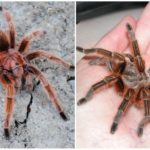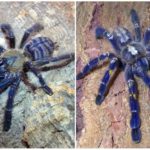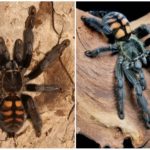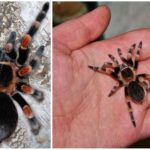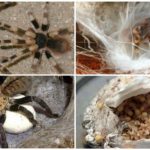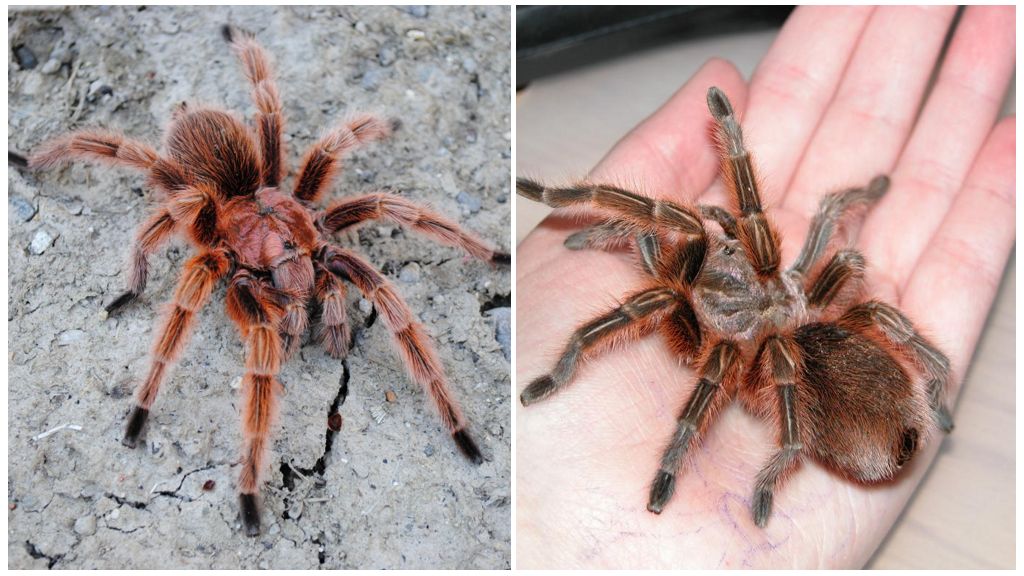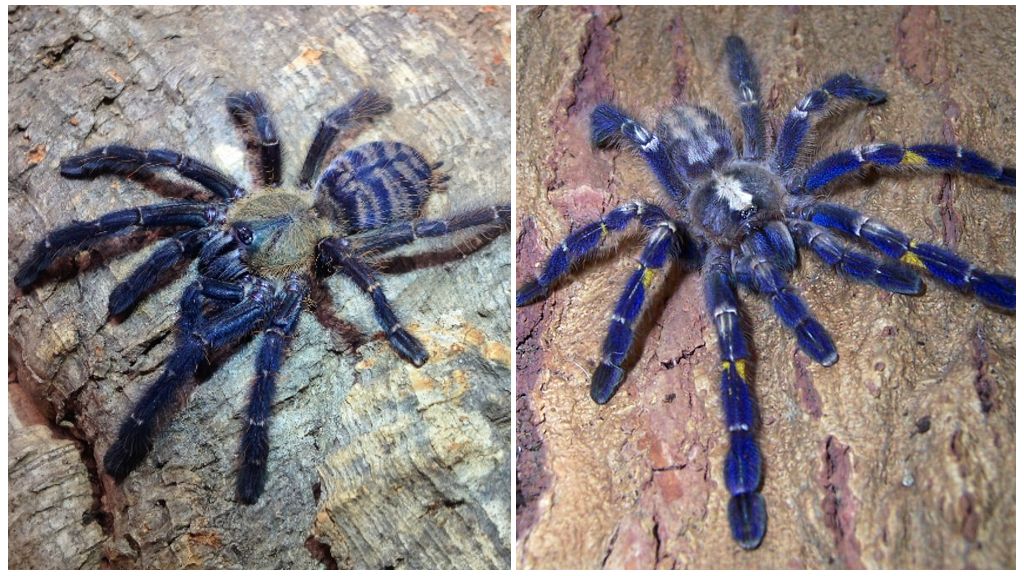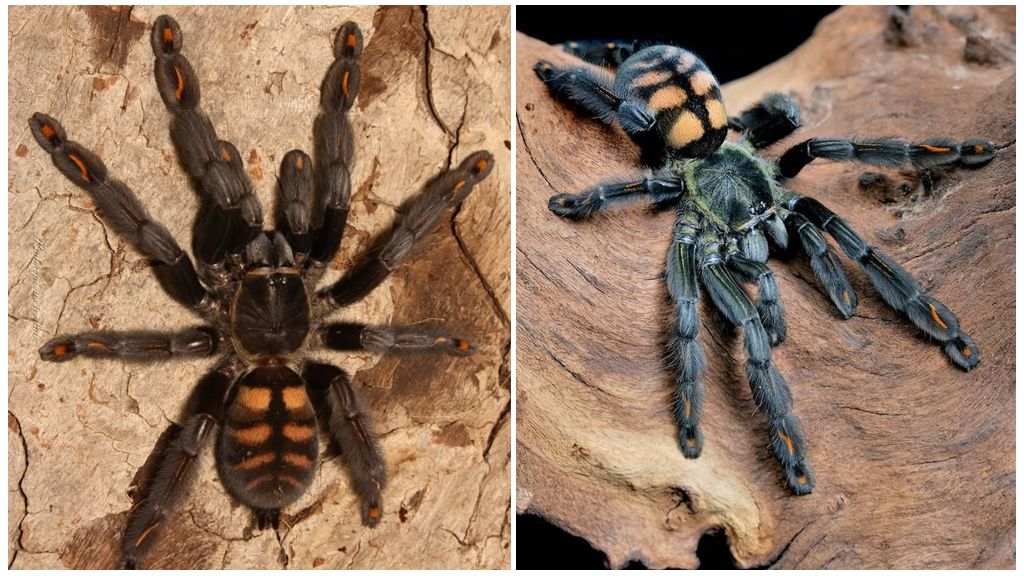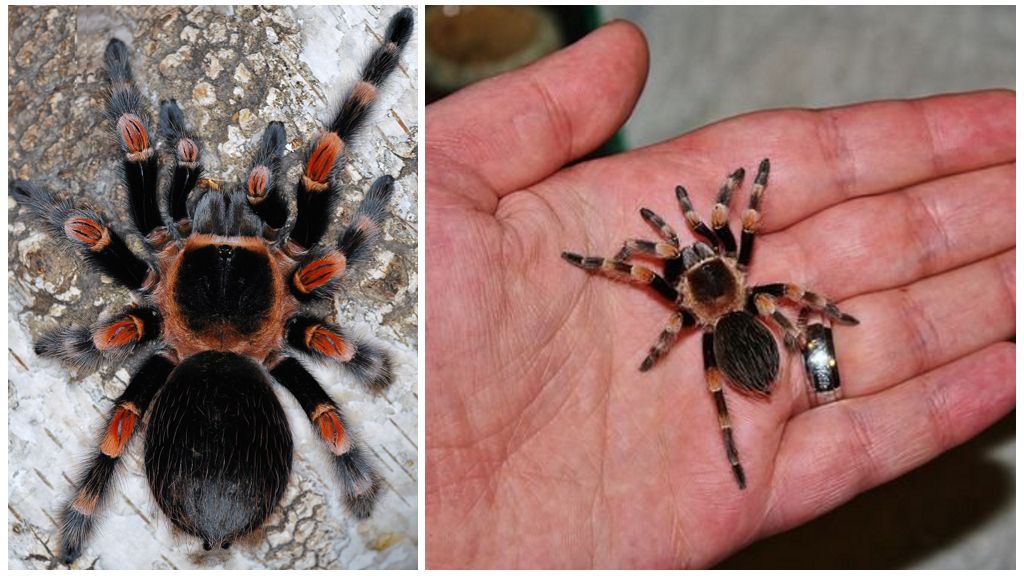Description and photos of tarantulas
Content
- Chilean pink tarantula
- Blue spider tarantula
- Tiger tarantula
- Spider brachipelma albopilosum
- Mexican spider tarantula
- Breeding tarantula
Bird-eating spiders, bird eaters (lat. Theraphosidae) are among the largest representatives of arachnids. In the span of the legs, their size reaches 27 cm.Exotic species live in tropical countries, weave a huge cobweb, hunt large insects, rodents, amphibians, birds. In Russia, tarantulas are kept as a pet.
Appearance, structure
Conventionally, the body of the spider is divided into the abdomen, the cephalothorax. The insides are protected by a durable chitinous coat. On the front of the chest - the head is located 4 pairs of eyes, providing the tarantula with a wide visual range. The spider sees shadows, silhouettes, movement. The organs of smell, sense of touch help to orient in space.
Limbs 8, attached to the cephalothorax, a pair of chelicera. Legs are massive, long. The largest tarantula in the world - 28 cm, hit the Guinness Book of Records. On average, the size of the spider with its paws is 25 cm. The color of the tarantula is bright, exotic. Paws are shaggy, the body is covered with bristles. The average weight is 85 g. Brazilian tarantulas weigh about 150 g. The largest goliath is 170 g. The photo of the tarantula spider is located below.
Interesting!
The body is covered with poisonous hairs. The spider weaves them into the web when building a nest, a cocoon for the larvae. Shakes off for self defense. Some species of tarantulas defend in an original way - they inject excrement in the direction of the enemy, thereby diverting attention.
Photo and description of the brightest species
Colorful spiders buy for big money lovers of the exotic. In terrariums with proper care, the pet lives to 25 years. As the animal looks like, you can see the photos below.
Chilean Pink Bird Eater (Grammostola rosea)
In natural conditions lives in the USA. Most common in Chile, hence the name. Sales in pet stores - one of the most popular, expensive. The size of an adult animal is 16 cm. Shaggy paws, the body is covered with hairs. The coloring is brown, pink in places, the body is covered with light hairs. Pink spider has a non-aggressive temperament, does not attack people, bites only for self-defense.
On a note!
Life expectancy of females is 15-20 years, but it can be longer. How many live in natural conditions is not known for certain.
Blue Bird Spider (Cyriopagopus sp. Blue)
Exotic view found in Malaysia. Blue, blue tarantula large size. Together with the size of the legs, the size is 25 cm. The whole body, the legs are covered with long thick hairs. The colors are the same everywhere with different tints in blue, blue, purple.
Predator poisonous, aggressive-minded, requires special care when being kept as a pet. The female reaches puberty after 3 years.They live in nature blue, blue, purple tarantulas more than 20 years. Throughout life, molt several times, slightly changing color. The eggs of the female lay up to 150 pieces at a time, large sizes in an independently formed cocoon.
Brindle tarantula (Psalmopoeus irminia)
The species was discovered in 1994 in Venezuela. The maximum body size is 6 cm, together with a leg span - 14 cm. Life expectancy is 15 years. Feels good in artificially created conditions. It is recommended to start as a pet as a confident beginner or an experienced collector, as the woody bird-eater is aggressive, poisonous, nimble.
Female reaches sexual maturity at 2 years old, lays up to 200 large eggs in a cocoon. In the natural environment is able to make another laying without prior fertilization. Males are much smaller in size, become mature in 1 year.
On a note!
Externally - one of the most beautiful views. The body with the paws is covered with hair of a brilliant black color. On the abdomen there is a characteristic red or light brown pattern, resembling the coloring of a tiger.
Red-legged Mexican Tarant (Brachypelma Smithi)
Lives in the desert, arid places of Mexico. They live in burrows under the ground, cracks in the rock. Body size with legs 12 cm. Poisonous, moderately aggressive. Life expectancy is about 15 years. The coloring of an exotic animal is unique and attractive. The main tone is black, the hairs are light gray, on one segment of the extremity, the heads are bright red spots, a rectangular pattern. The female sheds throughout life, in males, this process stops after reaching puberty.
Brachypelma albopilosum spider (Brachypelma albopilosum)
Calm, slow, poisonous, but not dangerous to humans. Bites and sheds toxic hairs for self-defense. Lives in the tropics, mates in the rainy season. An immature female behaves aggressively; it can even kill a “boyfriend”. The color scheme is black, brown, beige. Body size with paws 15 cm. Grows slowly, female lives up to 20 years. Eggs are laid in a cocoon, up to 500 pieces at a time.
Mexican bird spider (Brachypelma emilia)
One of the brightest representatives of a large family. The first began to export from Mexico to Europe as a pet. The size of the animal is 16 cm together with wide open limbs.It has a calm, non-aggressive temper. Under natural conditions, it is active at night, hiding in secluded places during the day. Lives female 20 years.
On a note!
Emilia rarely reproduces abnormally. After fertilization, it can take 8 months. Eggs are laid in a self-formed cocoon or a suitable shelter. You can keep a pet for newbies, but professionals need to breed.
Habitats of tarantulas in nature
Distributed around the globe. Most species live in tropical countries - America, Mexico, Africa, Australia. Some species are found in Europe - Spain, Italy, Portugal.
Under natural conditions, tarantulas live in trees, shrubs, as well as in the soil, rocks. It often happens that the nymphs initially live underground in burrows, having matured, move to the trees. Almost all tarantulas slow, make sudden movements in case of urgent need. Satisfied females may not leave the shelter for several months.
Interesting!
How long the female can live depends on the habitat. Some species live to 30 years.Periodically fade, increase in size, somewhat change color. Males die immediately after mating or throughout the year. A weakened “dude” can be eaten by a female after mating.
What eats spider tarantula
The lifestyle of different species is somewhat different. Some representatives of the genus do not form trapping nets, guarding the victim from shelters, others weave a huge web in diameter up to 2 m. The canvas comes out so dense that it keeps birds, small rodents, lizards, frogs, snakes. The main ration consists of insects, beetles, small spiders.
The tarantula strikes the victim with poison, paralyzes, injects saliva, which dilutes the insides in a few minutes. The spider sucks the contents, leaving only chitinous cover from prey. Toxic substance acts on the nervous system, causing spasm, asphyxiation.
Interesting!
From the name you might think that spiders eat birds, eat meat. In reality, this is not entirely true. It is difficult for poultry farmers to digest solid food, which is why they prefer insects.
Breeding
Males reach sexual maturity at the age of 1-2 years, females at 2-5 years old. Individuals of the male sex before the marriage period weave webs,put on her seminal fluid. During the mating season, the spider collects sperm in a special bag - a cymbium, crawling towards the female. Hooks keeps her sexual organ, fills with seminal fluid.
After fertilization, the female becomes aggressive, if the male does not have time to escape, runs the risk of being eaten. After 1-8 months, the female begins to form a cocoon from the web, lays there from 50 to 2000 eggs. Embryos develop from several weeks to months - 20-106 days. All this time, the female protects the young, periodically reverses the cocoon. However, with a shortage of food can eat it all.
Spiders are born weak, sedentary. They do not eat for some time, therefore they coexist quite peacefully. After the first molt, they increase in size, acquire a characteristic color. The tarantula is growing slowly. The female sheds almost all life, even after becoming a mature individual.
Interesting!
Before throwing off the old skin, the tarantula ceases to eat, weaves a rug from the web, turns over onto its back, pulls itself off the cover. Shedding spider at the stage of maturation occurs every month.After puberty in males, this process stops, the female molts every year. Together with the old cover, the animal sheds parasites, fungi, bacteria, renews the poisonous cover of the villi.
Danger to humans
All tarantula spiders are poisonous. If they talk about a safe animal, it means poison of low toxicity. There are no officially registered deaths from a bite. However, there is evidence that cats died from a pet. Often the bite occurs in the dry - without injecting poison. Then only a small hematoma remains on the site of the attack.
An allergic reaction to a toxic substance depends on the state of the immune system, age. Spiders are potentially dangerous for children, people prone to allergic reactions, the elderly. The possible consequences are local skin allergies, breathing difficulties, muscle spasm, vomiting, abdominal pain, weakness, dizziness.
Under natural conditions, poisonous villi spiders drop at risk to their own lives, interweave into the web when a cocoon is formed with eggs, nests. In the terrarium, the tarantula relieves nap and stress.Inhalation leads to the development of allergies - rhinitis, cough, shortness of breath, difficulty breathing, tearing, etc.
At home, spiders are kept in terrariums, fed by insects. To train or to teach spiders to something is impossible.

